¿Desea instalar WordPress en su ordenador Windows de forma local?
Trabajar con WordPress en su ordenador le permite probar nuevas características de WordPress, aprender a desarrollar con WordPress y crear sitios web antes de migrarlos al servidor real.
En este artículo, le mostraremos cómo instalar correctamente WordPress en un ordenador con Windows utilizando dos métodos diferentes. Esto funcionará en Windows 8, Windows 10 y otras versiones de Windows también.
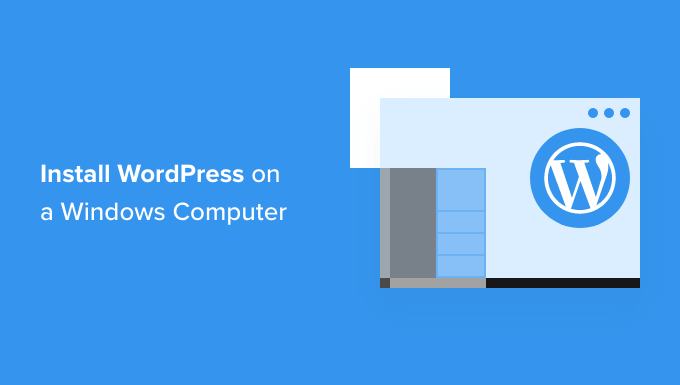
¿Por qué debería instalar WordPress en Windows?
La instalación local de WordPress en su ordenador le ofrece un entorno de pruebas que no afecta a su sitio web o blog. Una instalación de WordPress en su ordenador también se conoce como servidor local o localhost.
Normalmente, los desarrolladores de WordPress utilizan la instalación local de WordPress para desarrollar sus plugins y temas de WordPress.
Los usuarios principiantes también pueden instalar WordPress en sus ordenadores para aprenderlo, probar nuevos temas y plugins y experimentar sin afectar a un sitio web activo.
Nota: Si instala WordPress localmente en Windows, la única persona que puede ver ese sitio es usted.
Si quieres hacer un sitio web que esté disponible para el público, entonces necesitas tener un nombre de dominio y alojamiento web. Te recomendamos que sigas esta guía sobre cómo crear un blog en WordPress.
Dicho esto, veamos cómo instalar correctamente WordPress en un ordenador con Windows. Te mostraremos 2 formas sencillas, así que puedes enlazar abajo para saltar a cualquier sección que te interese:
- Método 1: Instalar WordPress en Windows usando WP Local
- Método 2: Instalar WordPress en Windows usando WampServer
Instalar WordPress en Windows usando WP local
Local WP, antes conocido como Local by Flywheel, es un software de alojamiento web local que le permite alojar un sitio web en su ordenador en lugar de en un servidor de ensayo o en vivo.
En primer lugar, debe descargar e instalar el software Local WP en su ordenador Windows. Simplemente vaya al sitio web de Local WP y haga clic en el botón “Descargar gratis”.
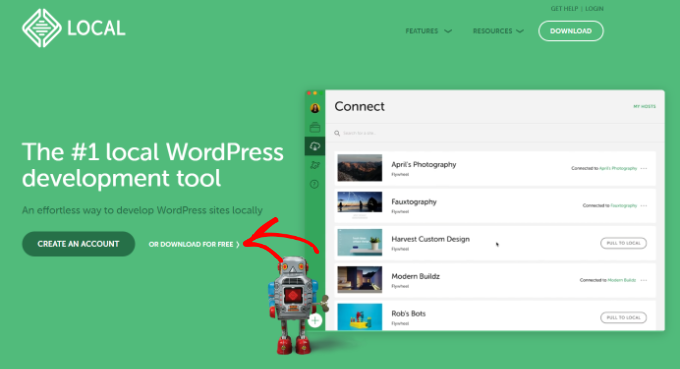
A continuación, aparecerá una ventana emergente en la que tendrás que seleccionar tu plataforma.
Elige “Windows” en el menú desplegable.
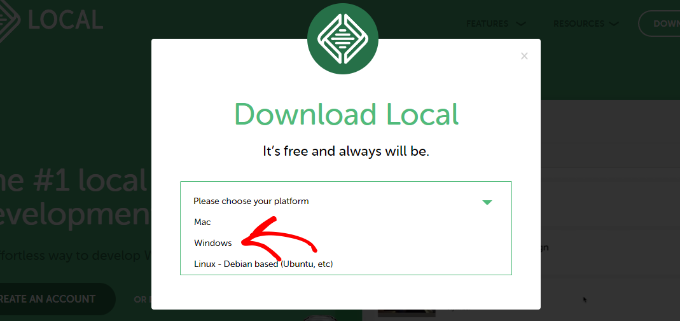
A continuación, puede introducir sus datos, como nombre y apellidos, dirección de correo electrónico del trabajo y número de teléfono, para descargar el software.
Una vez introducidos los datos, basta con hacer clic en el botón “Consíguelo ahora”.
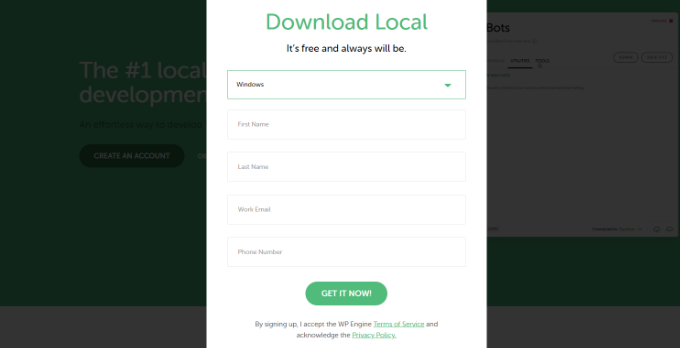
Después, puedes descargar el software en tu ordenador. Una vez descargado, inicia el asistente de instalación.
Ahora tendrás que seleccionar si quieres instalar el software para todos los usuarios o solo para ti. Cuando hayas seleccionado una opción, haz clic en el botón “Siguiente”.
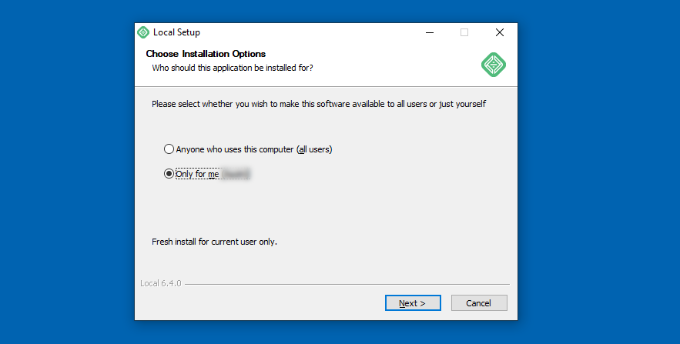
En el siguiente paso, puede seleccionar la “Carpeta de destino” donde se instalará el software.
Basta con hacer clic en el botón “Examinar” para establecer la ruta y, a continuación, hacer clic en el botón “Instalar”.
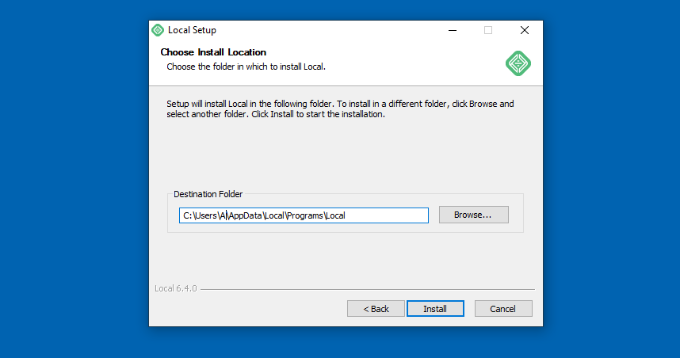
El software Local WP se instalará en tu ordenador Windows.
Una vez hecho esto, puede marcar / comprobar la casilla de verificación “Ejecutar localmente” y hacer clic en el botón “Finalizar” del asistente de configuración.
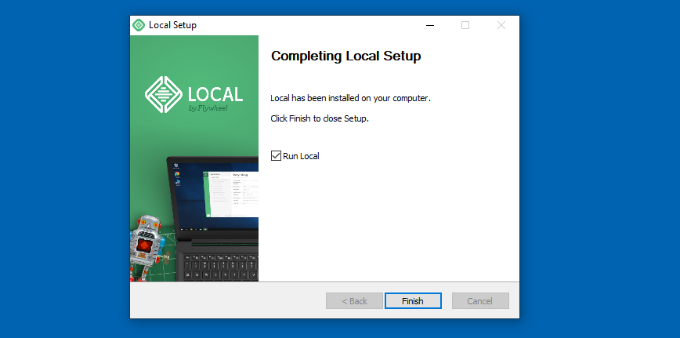
El software se iniciará ahora en su dispositivo Windows.
El siguiente paso es añadir un nuevo sitio web regional. Para ello, basta con hacer clic en el botón más (+) de la parte inferior.
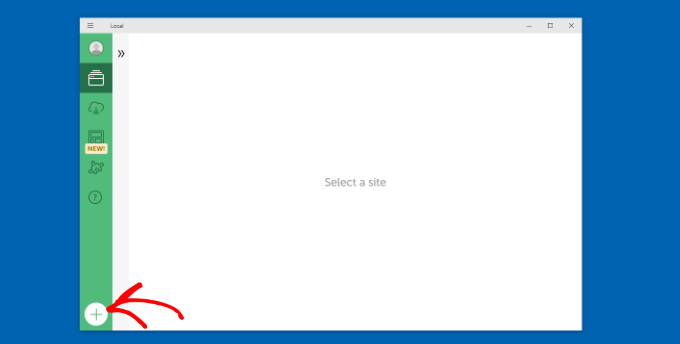
Después, puede crear un sitio en el software Local.
Seleccione la opción “Crear un sitio nuevo” y haga clic en el botón “Continuar”.
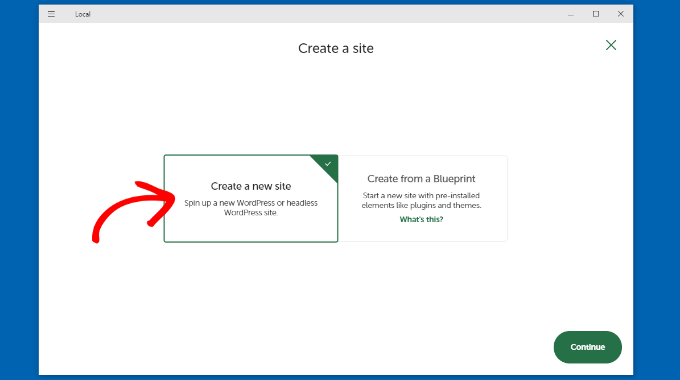
A continuación, puede introducir un nombre para su sitio web local, como wordpresslocalsite.
También hay opciones avanzadas en las que puede introducir el dominio del sitio local y la ruta del sitio local. Si está empezando, le recomendamos que mantenga los ajustes por defecto.
Una vez que haya terminado, simplemente haga clic en el botón “Continuar”.
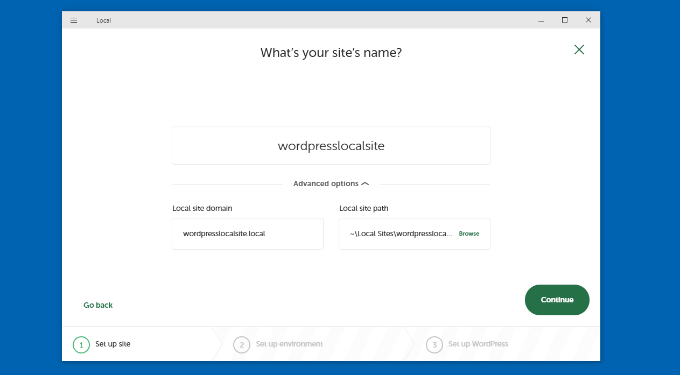
Después, tendrá que elegir un entorno para su sitio web local.
Puede utilizar el entorno ‘Preferido’, en el que el software seleccionará automáticamente la versión de PHP, el servidor web y la versión de MySQL. Por otro lado, también puede seleccionar ‘Personalizado’ e introducir los detalles del entorno.
Para este tutorial, utilizaremos los ajustes preferidos y haremos clic en el botón “Continuar”.
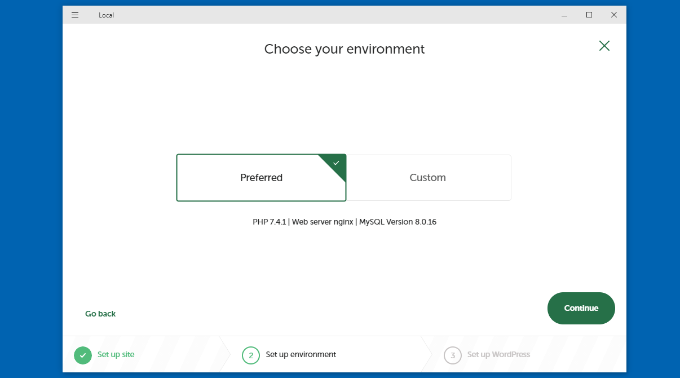
A continuación, puedes introducir un nombre de usuario y una contraseña de WordPress para tu sitio web local. Además, también tienes la opción de elegir una dirección de correo electrónico de WordPress en la que recibirás todos los avisos por correo electrónico.
También hay una opción avanzada en la que el programa le preguntará si tiene una red multisitio de WordPress.
Tras introducir estos datos, basta con hacer clic en el botón “Añadir sitio”.
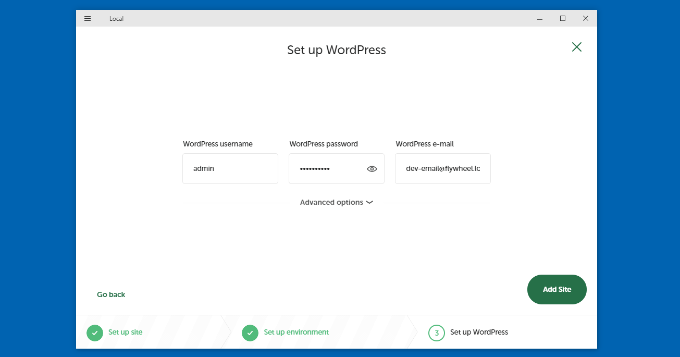
El programa instalará WordPress y establecerá su sitio web.
Para iniciar el sitio web regional, siga adelante y haga clic en el botón “WP Admin” en el software.
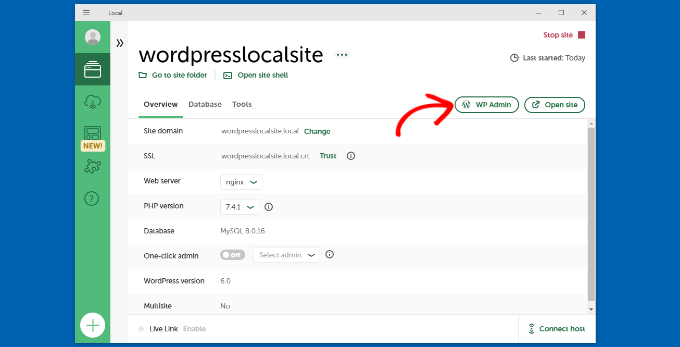
A continuación, verá la página de acceso / acceso del administrador de WordPress.
Sólo tiene que introducir el nombre de usuario y la contraseña que introdujo anteriormente al establecer el sitio web local y, a continuación, hacer clic en el botón “Acceder”.
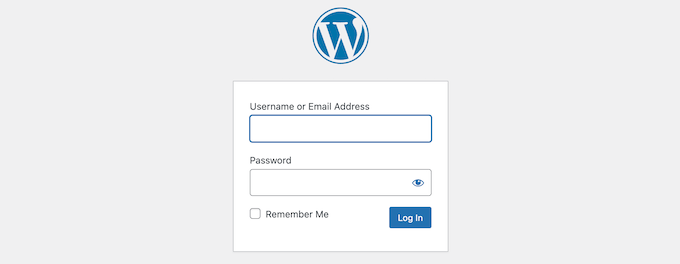
Ahora puede editar su sitio web local en su ordenador Windows.
Cuando haya terminado, no olvide detener el sitio web desde el software WP local al hacer clic en el botón “Detener sitio”.
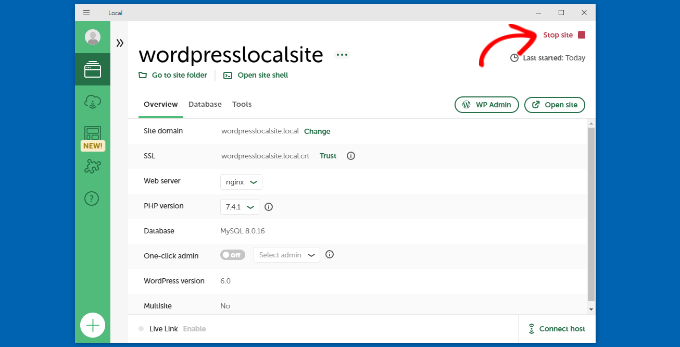
Instalar WordPress en Windows con WampServer
WampServer o WAMP es una compilación de servidor web Apache, PHP y MySQL en un lote para ordenadores Windows.
Todos ellos son programas independientes de código abierto. Sin embargo, instalarlos por separado no es del todo fácil incluso para usuarios experimentados. Software como WampServer le permite instalarlos fácilmente y tener un entorno local de trabajo en cuestión de minutos.
En primer lugar, debes descargar el software WAMP e instalarlo en tu ordenador. Sólo tienes que ir al sitio web de WampServer y hacer clic en el botón ‘Start Using WampServer’.
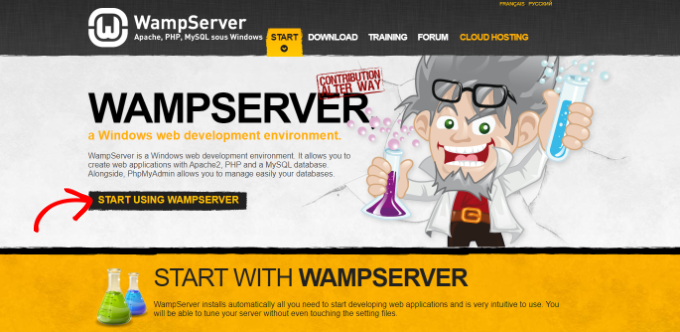
Te llevará a la sección de descargas. Aquí verás dos versiones: WampServer 32 bits y WampServer 64 bits.
Debe seleccionar la versión de WampServer que coincida con el tipo de sistema operativo de su ordenador Windows.
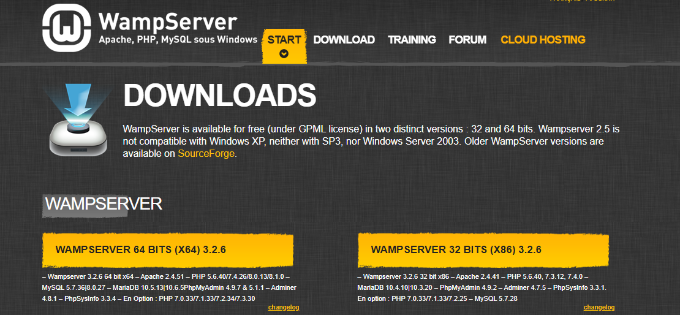
Para saber si utiliza un sistema operativo de 32 o 64 bits, busque “Panel de control” en la barra de búsqueda de la barra de tareas Inicio.
Después de eso, puede ir a Sistema y Seguridad ” Sistema en su ordenador. Allí usted será capaz de ver su tipo de sistema.
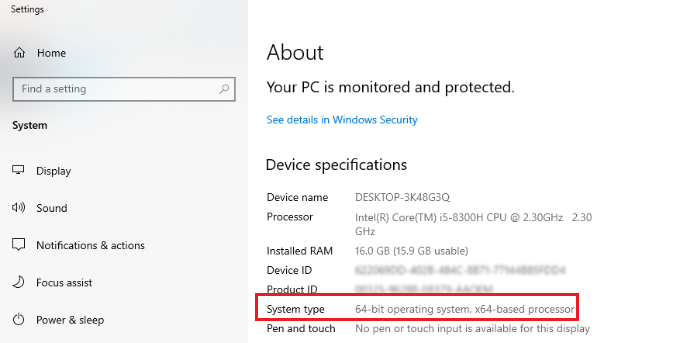
Ahora que conoce su tipo de sistema operativo Windows, sólo tiene que seleccionar la versión correcta del software WampServer.
Al hacer clic en el botón de descarga, se abrirá un formulario en el que se le pedirán sus datos personales. Si no desea facilitarlos, haga clic en el enlace “Puede descargarlo directamente”.
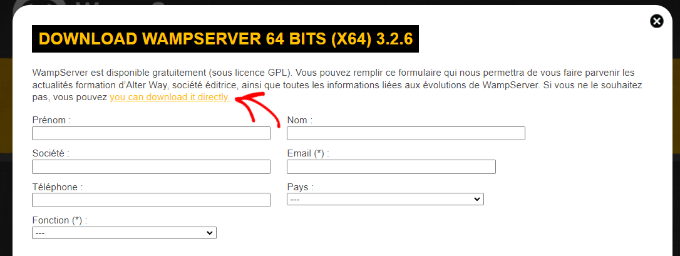
Una vez descargado, puedes hacer clic en el archivo de ejecución de WampServer para ejecutar la instalación.
Seleccione ahora un idioma en el menú desplegable y haga clic en el botón “Aceptar”.
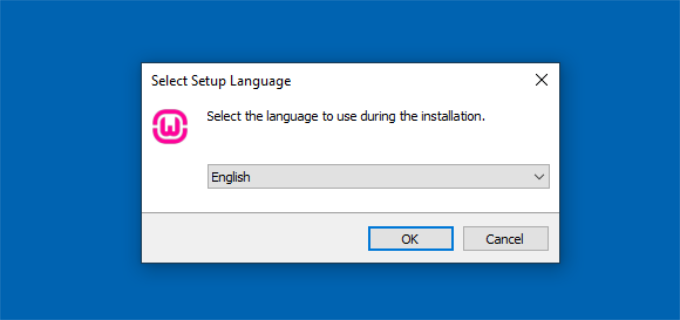
En el siguiente paso, verá el Acuerdo de licencia.
Seleccione la opción “Acepto el acuerdo” y haga clic en el botón “Siguiente”.
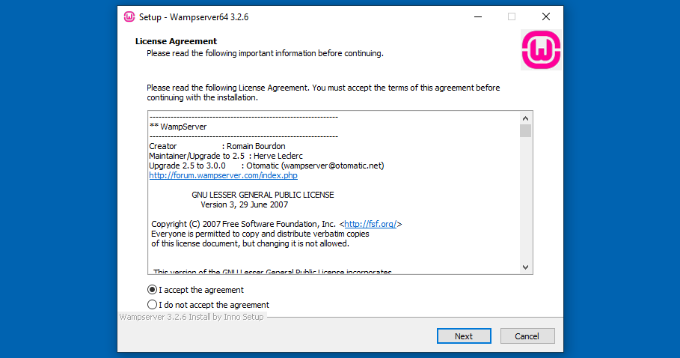
A continuación, el asistente de instalación mostrará información acerca de la instalación de WampServer.
Sólo tiene que hacer clic en el botón “Siguiente” para continuar.
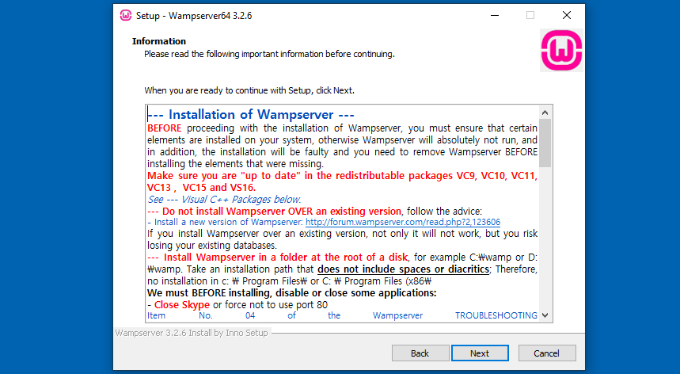
A continuación, puede seleccionar la ubicación de destino donde se instalará el software.
Para cambiar la ubicación por defecto, haz clic en el botón “Examinar” y elige la carpeta que prefieras. Cuando hayas terminado, haz clic en el botón “Siguiente”.
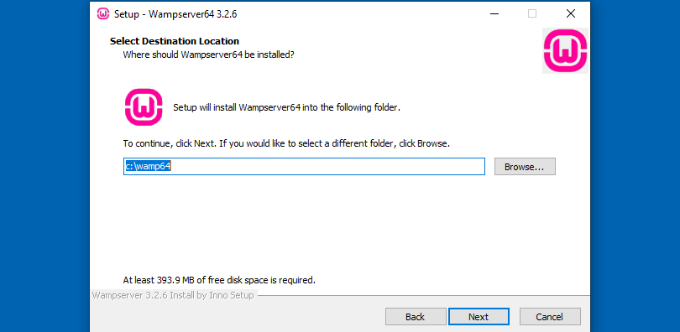
El asistente de instalación le pedirá que seleccione los diferentes componentes que desea instalar. Entre ellos se incluyen las versiones de PHP, MySQL, etc.
También puede mantener las opciones por defecto y hacer clic en el botón “Siguiente” para avanzar.
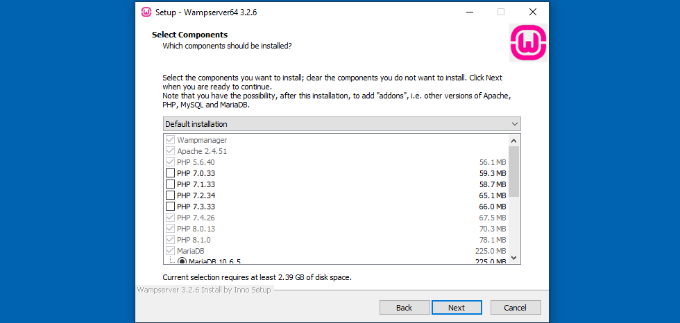
A continuación, puedes seleccionar una carpeta del menú de inicio. Adelante, haz clic en el botón “Examinar” para elegir otra carpeta.
Cuando haya seleccionado una carpeta, haga clic en el botón “Siguiente” para continuar.
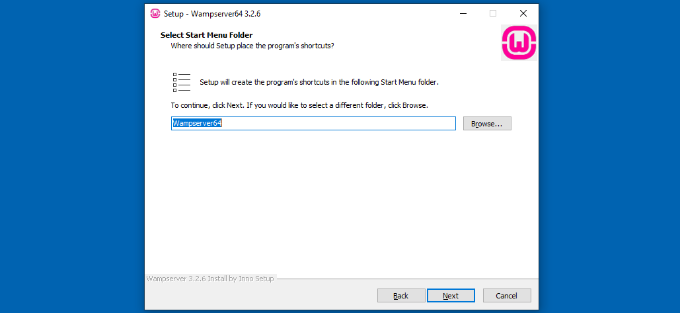
Ahora el software estará listo para instalarse. Podrá ver un resumen de la ubicación de destino, el tipo de instalación, los componentes seleccionados, etc.
Sigue adelante y haz clic en el botón “Instalar”.
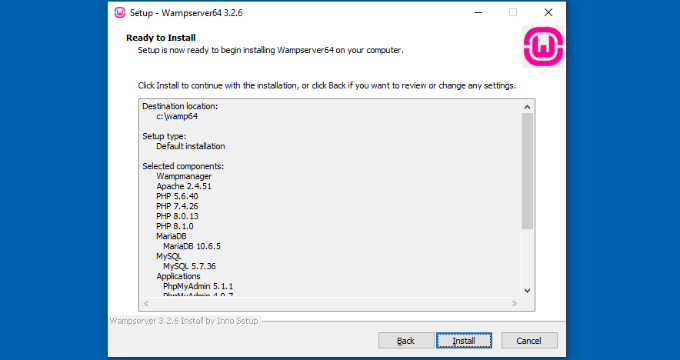
Durante el proceso de instalación, debe definir la ubicación del navegador / explorador web. Por defecto, será Internet Explorer.
Puedes cambiarlo por Google Chrome o cualquier otro explorador web localizándolo en los Archivos de programa de tu ordenador.
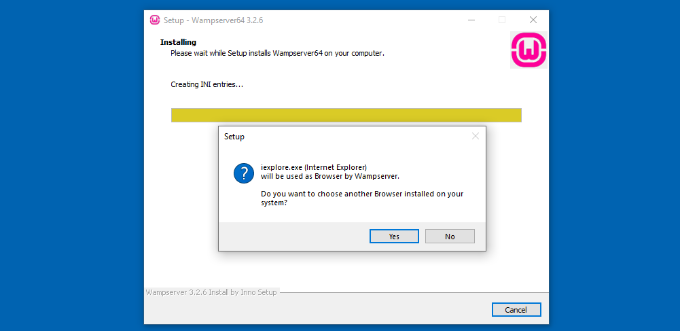
Del mismo modo, también le preguntará si desea utilizar el Bloc de notas cuando utilice WampServer.
A continuación, el asistente de instalación mostrará información acerca de cómo funciona WampServer.
Siga adelante y haga clic en el botón “Siguiente”.
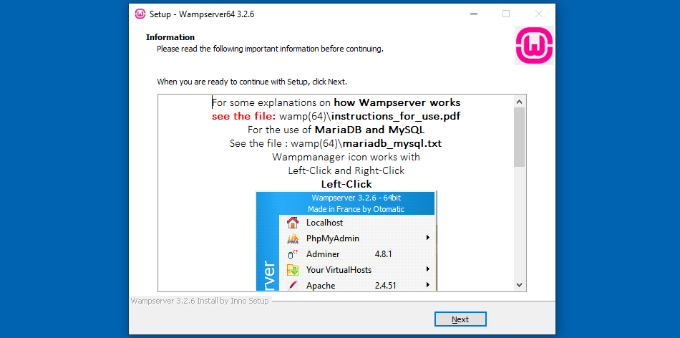
Ha instalado correctamente WampServer en su dispositivo Windows.
Basta con hacer clic en el botón “Finalizar” para salir del asistente de configuración.
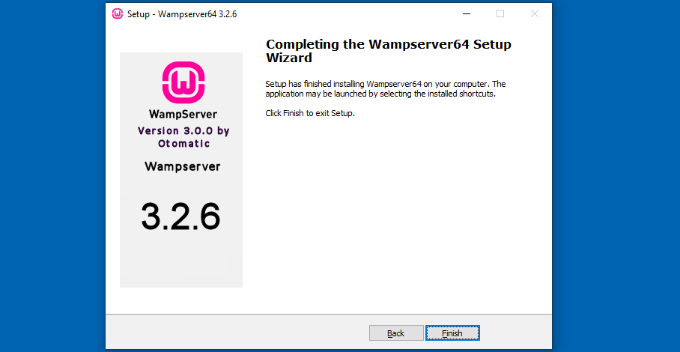
Una vez instalado, puedes iniciar el WampServer desde el atajo de tu escritorio o desde la ubicación de destino donde instalaste el software.
Lo siguiente que tienes que hacer es crear una base de datos MySQL en blanco.
Al iniciar WampServer, verás un icono verde en la esquina inferior derecha de tu pantalla junto con otros iconos. Simplemente haz clic con el botón izquierdo del ratón sobre él y, a continuación, haz clic en phpMyAdmin (una aplicación basada en web para gestionar bases de datos MySQL).
Nota: Si el icono de WampServer está rojo o amarillo, significa que los servicios (Apache, MySQL, PHP) no se están ejecutando. Debe iniciar los servicios al hacer clic en el icono antes de establecer la base de datos.
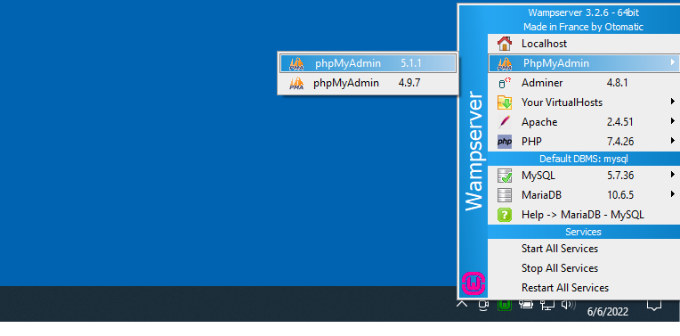
Le llevará a la pantalla de acceso a phpMyAdmin en su navegador / explorador.
Simplemente introduzca el nombre de usuario: root y deje el campo de contraseña en blanco. Estas son las credenciales por defecto para acceder / acceder a su localhost phpMyAdmin.
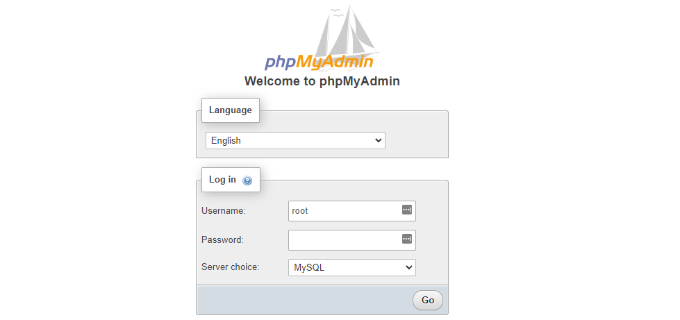
Haga clic en el botón “Ir” para continuar.
Una vez conectado, debe hacer clic en Bases de datos en phpmMyAdmin para crear una nueva base de datos para WordPress.
Te pedirá que elijas un nombre para tu nueva base de datos (nosotros la llamamos test_db). A continuación, haz clic en el botón “Crear”.
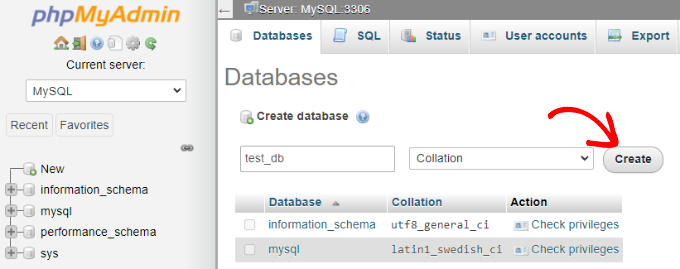
Su base de datos está lista, lo que significa que ya puede instalar WordPress en localhost.
Lo siguiente que tienes que hacer es descargar la última versión de WordPress desde el sitio web WordPress.org. Se descargará como un archivo zip.
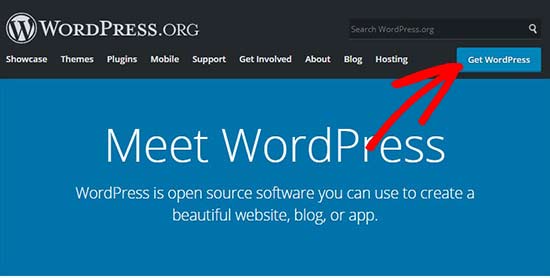
A continuación, debe extraer el archivo zip y copiar la carpeta ‘wordpress’.
Para este tutorial, vamos a utilizar WinRAR para descomprimir el archivo. Simplemente haga clic en la opción ‘Extraer a’ en la parte superior.
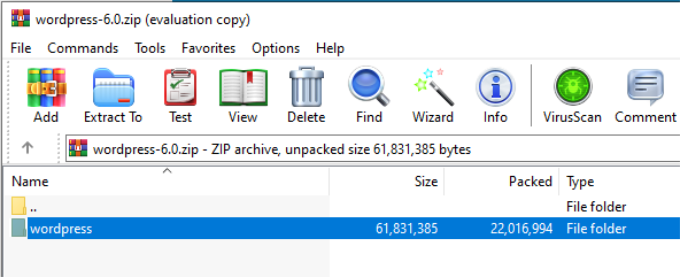
Ahora necesitas navegar a la carpeta donde instalaste WAMP.
En este tutorial, instalamos WAMP en C:\wamp64, así que nos referiremos a esa carpeta en adelante. Sin embargo, ten en cuenta que puede ser diferente para ti dependiendo de donde hayas instalado el programa.
Pega la carpeta ‘wordpress’ en la carpeta C:\wamp64\www.
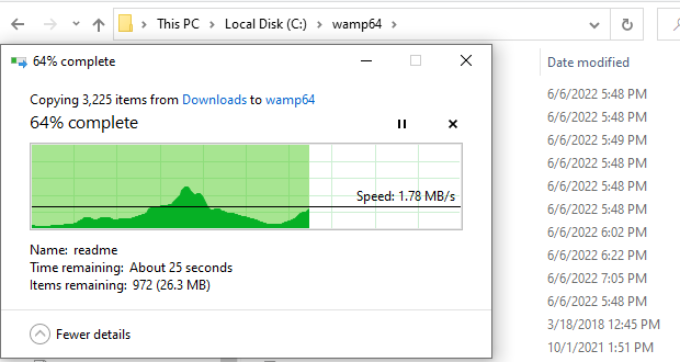
Puedes cambiar el nombre de la carpeta ‘wordpress’ por el que quieras, como mysite, testsite, etc. Esta será la URL de tu sitio local de WordPress, así que asegúrate de elegir algo que recuerdes fácilmente.
Por el bien de este tutorial, hemos cambiado el nombre de la carpeta de wordpress a mysite.
A continuación, puede abrir el navegador / explorador web e ir a http://localhost/mysite/ y hacer clic en la carpeta ‘wordpress’.
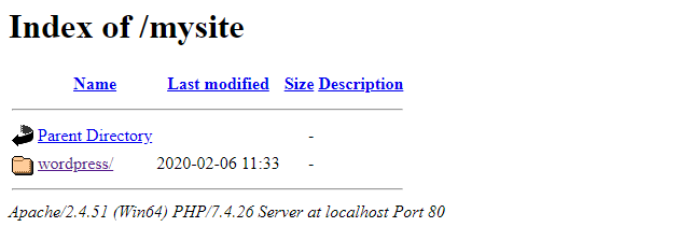
En primer lugar, te pedirá que selecciones un idioma y, a continuación, te mostrará la información de configuración de la base de datos.
Tras seleccionar un idioma, haga clic en el botón “Continuar”.
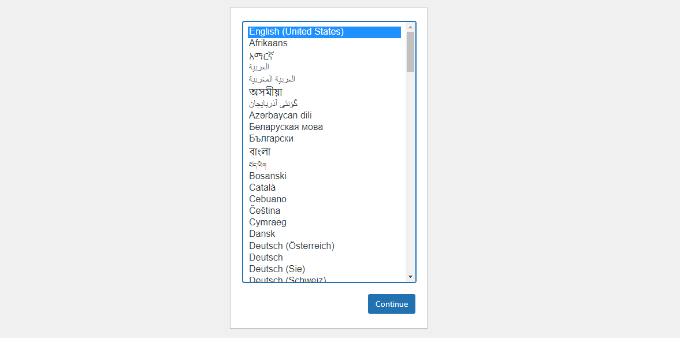
A continuación, verás un aviso de bienvenida a WordPress.
Una vez que lo haya leído detenidamente, siga adelante y haga clic en el botón “Vamos” para continuar.
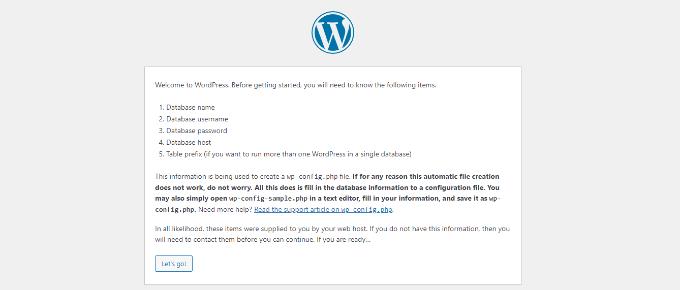
A continuación, deberá introducir los datos de la base de datos, como el nombre de la base de datos, el nombre de usuario, la contraseña, el alojamiento y el prefijo de la tabla.
El nombre de la base de datos será el que introdujiste en el paso anterior. En nuestro caso, la hemos llamado ‘test_db’. El nombre de usuario será ‘root’, y puedes dejar el campo de contraseña en blanco. También puedes dejar como están el alojamiento de la base de datos y el prefijo de la tabla.
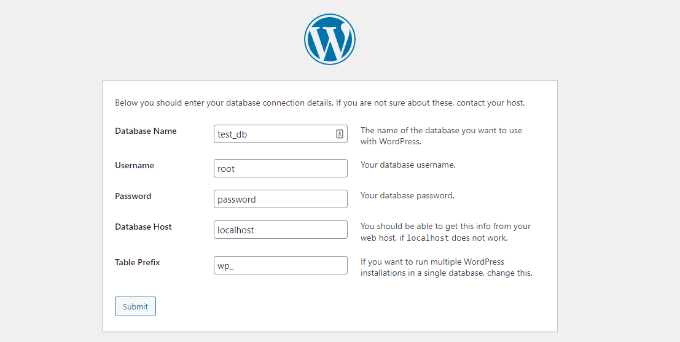
A continuación, haga clic en el botón “Enviar” y WordPress creará un archivo de configuración para usted en la administración / escritorio.
En la siguiente pantalla, verá un mensaje de correcto indicando que WordPress está conectado a su base de datos, y puede proceder con la instalación.
Sigue adelante y haz clic en el botón “Ejecutar la instalación” para continuar.
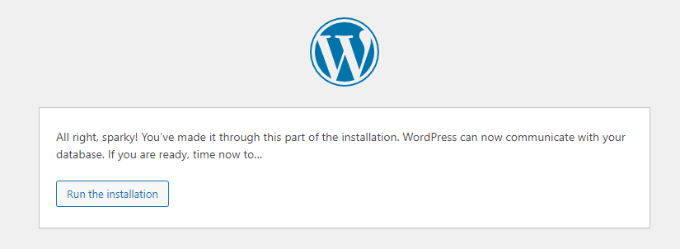
Te llevará a la pantalla de bienvenida de WordPress. Deberá añadir un título para su nuevo sitio web de WordPress, elegir un nombre de usuario de administrador, introducir una contraseña segura y proporcionar una dirección de correo electrónico de administrador.
Cuando estés listo, haz clic en el botón “Instalar WordPress”.
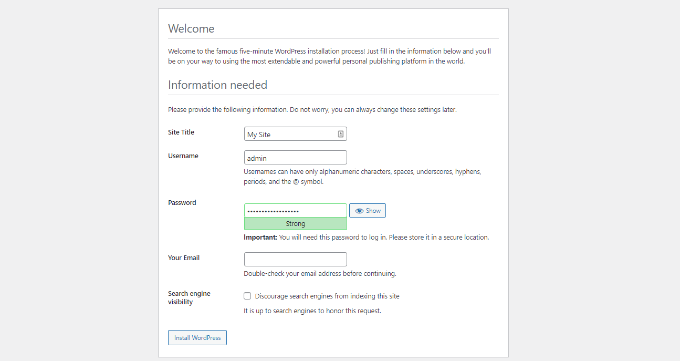
Una vez finalizado el proceso de instalación, verá un mensaje de correcto. En segundo plano, WordPress ha creado nuevas tablas en su base de datos y está listo para usar.
A continuación, puede acceder a su escritorio de WordPress haciendo clic en el botón “Iniciar sesión”.
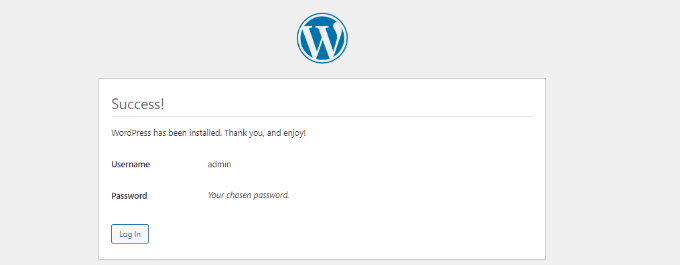
Enhorabuena, has instalado correctamente WordPress en un ordenador Windows utilizando WampServer.
Sólo tiene que acceder / acceder a su panel de administrador de WordPress y empezar a editar su sitio en un entorno regional.
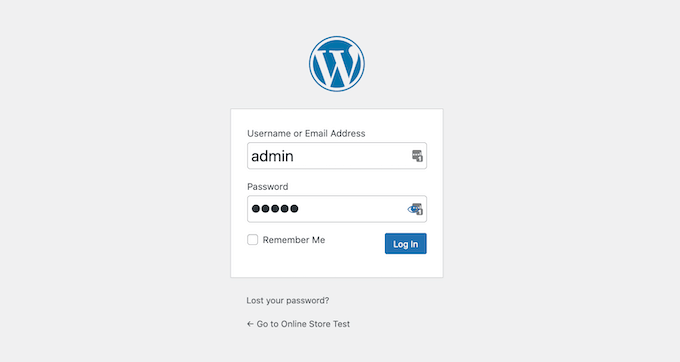
Activando Enlaces permanentes bonitos en WAMP
La nueva versión de WordPress no rompe su sitio local cambiando la configuración de los enlaces permanentes.
Sin embargo, si todavía ve el error ‘página no encontrada’ en sus páginas después de cambiar los enlaces permanentes desde Ajustes ” Enlaces permanentes en WordPress, entonces simplemente siga nuestra guía sobre cómo activar enlaces permanentes personalizados en WAMP.
Bonificación: Migración de WordPress local a WordPress activo
También hemos escrito una guía independiente sobre cómo trasladar WordPress de un servidor local a un sitio en producción. Esperamos que te resulte útil cuando estés listo para desplegar tu sitio local a producción.
Disponer de un entorno de servidor local es estupendo para aprender y realizar pruebas. Sin embargo, si desea iniciar un blog de WordPress para que otras personas lo vean, entonces no necesita instalar WordPress en su ordenador. Necesitas instalar WordPress en un proveedor de alojamiento WordPress.
Esperamos que este artículo te haya ayudado a aprender cómo instalar WordPress en un ordenador con Windows. Puede que también quieras ver nuestra guía sobre WordPress SEO y cómo crear una tienda online.
If you liked this article, then please subscribe to our YouTube Channel for WordPress video tutorials. You can also find us on Twitter and Facebook.





Syed Balkhi says
Hey WPBeginner readers,
Did you know you can win exciting prizes by commenting on WPBeginner?
Every month, our top blog commenters will win HUGE rewards, including premium WordPress plugin licenses and cash prizes.
You can get more details about the contest from here.
Start sharing your thoughts below to stand a chance to win!
Moinuddin Waheed says
This is the best method for anyone who just want to learn and gets hands dirty before actually making a big debut in the WordPress industry.
I have used both the methods local by flywheel and wampserver for local installation of WordPress.
I have also used xampp server for wordpress installation and have experimented with many themes and plugins.
Konrad says
Everything went smoothly, no issues with installation, thanks to the simple yet effective guide. Much appreciated!
WPBeginner Support says
Glad to hear it worked for you
Administrador
saajina says
Hi. i am new to WordPress and i am trying to install WampServer. i downloaded WampServer from the link you mentioned above. and i tried to install after download , i choose english language after that i accepted the agreement. after that when i click on the next button to install a pop come by saying this installation can only work if the above vc++ package is installed ……. and please cancel the installation . i don’t know what to do next. please help me
WPBeginner Support says
It would depend on which VC++ package is missing but you should be able to go to the Microsoft website and search for the Visual C++ library that WAMP needs to download and install it.
Administrador
Jiří Vaněk says
Thank you for the guide. Usually, I’ve always tested WordPress, for instance, on services like instawp.com, or I’ve set up everything myself in some virtualization tool on a Linux distribution. This looks quite simple.
WPBeginner Support says
Glad you found this a helpful option
Administrador
sieutonghop says
Is Local WP website data guaranteed?
WPBeginner Support says
I don’t think I understand what you’re asking, the files and your content are stored on your computer.
Administrador
kiemtienspeed says
If using Local WP, where will the website data be saved? Can you explain more clearly?
WPBeginner Support says
The data would be stored in the database and the files would be saved in the site’s folder.
Administrador
Jiří Vaněk says
It’s practically the same as with WordPress on shared hosting. The database can then be exported via PHPMyAdmin, and data via an FTP client (FTP data is stored in a folder locally on the computer). Alternatively, a migration plugin can be used, just like on the server.
Koweh says
Hi, please is the a video explainable for the above steps to install Install WordPress on Windows Using WampServer?
WPBeginner Support says
Not at the moment but we will consider that for future videos!
Administrador
M Sohail says
this article is very helpful to me.
Thanks to all Team
WPBeginner Support says
Glad to hear our post was helpful!
Administrador
Danielle says
Hi, very helpful article. How would you do this for an existing WordPress site? (I’m hosting on Hostinger and selected WordPress to construct my site). I already have a domain name and login for WordPress as well.
WPBeginner Support says
To move a currently active site to a locally installed WordPress site, you would want to take a look at our guide below!
https://www.wpbeginner.com/wp-tutorials/how-to-move-live-wordpress-site-to-local-server/
Administrador
Joseph Lewinski says
Fabulous instruction set. I installed WAMP Server simply and without a hitch. There was only one very minor “glitch” in your instructions, which were easy enough to figure out. When the instructions explain the installation of WordPress proper, it says, “Paste the ‘wordpress’ folder into the C:\wamp64\www folder.”, but the IMAGE shows you installing it into the C:\wamp64 folder. Like I said, easy enough to figure out (I used your WORDS, NOT the IMAGE).
THANK YOU for this! I’m subscribing NOW!
WPBeginner Support says
Glad our guide was helpful and thank you for pointing that out!
Administrador
Duncan Philps-Tate says
Hi useful article. The only thing I’m aware of not seeing is anything about when to use Local WP and when to use WAMP. Now I’ve got a choice and I don’t know which is better for me.
Local WP sounds more straightforward and with less to do – but the test doesn’t say whether it also installs Apache, PHP, MySQL (which the WAMP text does say).
On the other hand, WAMP sounds like you have to do more getting it going (just compare the number of paragraphs it needs) but apart from (possibly) adding choice over Apache, PHP, MySQL, what does it give you that Local WP doesn’t?
Hope you can answer this easily.
WPBeginner Support says
WAMP has been around longer and was our original recommendation, Local WP was created to make it easier for those just starting out and both will install what is needed to run a WordPress site on your computer.
Administrador
Duncan Philps-Tate says
Thanks – useful
Seyi says
Thanks for this… really helpful
WPBeginner Support says
Glad our article was helpful!
Administrador
Kylie says
I have installed wampserver and have a green light. When I right click I can not find any button called phpadmin. And when I type localhost/phpadmin in my browser I am getting this message.
The requested URL was not found on this server.
Apache/2.4.51 (Win64) PHP/7.4.26 Server at localhost Port 80
WPBeginner Support says
You would want to left-click on WAMP’s icon for phpmyadmin, when you go through that route it should show what your URL is set to if it is not properly set under localhost.
Administrador
Layla says
I’ve done this and started work on one pc but this now needs to go for repair and will be away a while. If I am to install this on a second pc, what files do I need to transfer over so I can continue working on the same website on the other pc? Feeling a bit dumb here that I can’t figure it out myself.
WPBeginner Support says
We would recommend following our guide below for transferring your site to a different computer to continue working on it. While the article is for live sites, the method should still work for your local installation.
https://www.wpbeginner.com/wp-tutorials/how-to-move-live-wordpress-site-to-local-server/
Administrador
Layla says
Thank you so much! That worked perfectly and was so simple!
WPBeginner Support says
Glad we could help!
Renata says
I installed Wamp Server and C++ Redistributable 2012, 2013 and 2015 but when I try to open it it opens 4 black windows and then it shuts down. What should I do
WPBeginner Support says
You would want to check in the bottom right with your hidden icons, WAMP does not have a window pop up by default but would add an icon there for your options with WAMP
Administrador
Hosea says
Straightforward and to the point guide. Followed it and achieved exactly what I wanted. Great and helpful write-up.
WPBeginner Support says
Glad you found our guide helpful
Administrador
Ibrahim Yusuff says
Thanks for this invaluable guide. The issue of having is with the wamp download. The language is in French and each time i try to change it it goes back to french which i do not understand. i filled all the necessary information but to click on download it changes back to french. pls help me out on this
WPBeginner Support says
They currently have a popup that is French when selecting the file to download but at the end of the first paragraph you should see a link to download directly without having to deal with the popup
Administrador
prilla kobugabe says
hello, i need some help. when i put this localhost/mysite/ in my web browser it responds negatively saying
“The requested URL was not found on this server.
Apache/2.4.41 (Win64) PHP/7.3.12 Server at localhost Port 80”
WPBeginner Support says
If you have restarted your computer since installing WAMP you would want to ensure that WAMP is running as that is the most common cause of that specific error.
Administrador
Ronnie Ferrer says
You are legend guys! Thanks.
Francis Guchie says
Thank you so much for this very nice article for beginners
prakoo says
api-ms-win-crt-string-l1-1-0.dll is missing from your computer it shows error?
WPBeginner Support says
You would want to ensure you install Visual C++ Pro for the most common solution to that error.
Administrador
Melissa says
Hi – I have WAMP installed locally on my Windows 10 machine running PHP version: 7.3.12. I want to upgrade to PHP 7.4 – do I need to reinstall WAMP or can I update PHP separately?
WPBeginner Support says
You would want to click on the WAMP icon, and check under PHP, Version and depending on when you installed WAMP there should be the option to change versions by clicking on the version you want to use.
Administrador
melissa says
thanks – this was perfect advice!
Holly says
Thanks for this article! It is the best and most straight-forward one I’ve come across, it’s very helpful and detailed. Keep up the great work! As a beginner, I really appreciate it.
WPBeginner Support says
Glad you found our guide helpful
Administrador
Jules Ivan says
This is awesome! Thank you for making this article!
WPBeginner Support says
Glad you found our guide helpful
Administrador
Ben says
While installing, I got a System error that says ”The code execution cannot proceed because MSVCR120.dll was not found. Reinstalling the program may fix this problem'”
How can I get this done please
WPBeginner Support says
You need to install Visual C++ Redistributable that we link to in the article
Administrador
Diya says
I have installed wordpress in wamp and completed my first website. I have got another project now. So for the second website how should I start?Should I install wordpress again in a second “mysite2” folder?
WPBeginner Support says
You can certainly do that for the most common method for creating a new site.
Administrador
saheed says
im receiving myssqld.exe- system error. how do i fix it
WPBeginner Support says
You would want to ensure you installed Visual C++ Redistributable
Administrador
Tom Bauer says
WAMP64 will not install on a win7 64 machine.
WPBeginner Support says
Unless we hear otherwise, you can install it on Windows 7 still, depending on the error you are running into, you may need to reach out to WAMP’s support.
Administrador
Paul says
Great instructions, thanks.
Everything installed fine, just have a problem this morning in trying to log into the browser. Every setting I have tried hasn’t worked.
I know I am being thick but could you confirm what I should be typing in the browser to access the program.
Thanks
WPBeginner Support says
As we state in the article, it should be something similar to localhost/mysite. You would also want to ensure WAMP is running for the most common reason for that issue.
Administrador
Peter says
I was having similar issue as others. All went well until I got to the point with Apache not running. The issue was with Port 80 it was used by something else (not skype) so I went to Tools > Use other port than 80 I added the port 8080. Then it all worked however then when you want to access your website you can’t use localhost/mysite/ but localhost:8080/mysite/ since you changed the default port.
I didn’t find this in the comments. Maybe it will help someone.
WPBeginner Support says
Thanks for sharing what helped you with this issue
Administrador
Bas says
Hi, thanks for the tutorial. I completed it, and it works like a charm. But now my question is: how do I get my “real” live website data in the local test environment? Is there some way to export that and import it into the local test environment?
WPBeginner Support says
For that, you would want to take a look at our article below:
https://www.wpbeginner.com/wp-tutorials/how-to-move-live-wordpress-site-to-local-server/
Administrador
Mahima Pandey says
here i have downloaded the wordpress file and done everything according to the given instruction . but lastly stuck in the localhost address bar
localhost/servername in the internet explore has to be typed to get to wordpress. but what to be type for google ,firefox. pls lhelp me with this its really urgent.
WPBeginner Support says
You should be able to type that same address on any internet browser to see the site on your local computer. If you wanted to have your site found online, you would want to look into a domain and hosting provider.
Administrador
Konstantinos Paturas says
Thank you so much.
WPBeginner Support says
You’re welcome
Administrador
Armel says
Thanks for this useful article. I successfully installed WordPress using Wamp. But, I get this message. “Installation failed: there has been a critical error on your website. Please check your site admin email inbox for instructions. Learn more about debugging in WordPress.”
Please, how can i fix it ?
WPBeginner Support says
For that error, you would want to take a look at our article below:
https://www.wpbeginner.com/wp-tutorials/how-to-fix-the-wordpress-white-screen-of-death/
Administrador
Hoat Le says
Dear WPBeginner Support;
I read your tut very carefully, and didn’t see you mention about VirtualHost in WampServer, so I don’t know if I have to create a Virtual Host for my test site.
WPBeginner Support says
It can make URLs closer to what you would expect from a site but it is not a requirement and can be difficult for beginners to set up.
Administrador
Shani says
Hello,
Thank you so much for this article!
You’ve really helped me!
I’m interested to know now how to login to my site when I go on wordpress.
WPBeginner Support says
If you can navigate to your WordPress site then you would add /wp-admin to the end, we cover a few more options in our article below that you can also try:
https://www.wpbeginner.com/beginners-guide/how-to-find-your-wordpress-login-url/
Administrador
mimi says
I followed the process accordingly but when i click on the green WAMP icon in order to create a blank MySQL database nothing pops up
WPBeginner Support says
The most common reason for that would be if you didn’t install the C++ redistributable if you have not done that.
Administrador
Aminat says
Thanks a lot, really helpful
WPBeginner Support says
You’re welcome
Administrador
Dav says
Hi,
I have installed as per instructions but I am getting an error trying to log into
ERROR: Failed to set session cookie. Maybe you are using HTTP instead of HTTPS to access phpMyAdmin.
What am I doing wrong?
WPBeginner Support says
That is likely a hiccup with either your browser cache or a browser addon, we would recommend clearing your cache or trying to use an incognito browser to see if that helps resolve the issue.
Administrador
Dav says
Thanks, that works
Nathan Zindikilani says
Hi, thank you for the article. when i try to open my local host site i get the following error; There has been a critical error on your website.this is after pasting ‘wordpress’ to www folder. how may i solve this
WPBeginner Support says
You would want to ensure the file is unzipped, if it is you may want to try reading a fresh WordPress download to the folder to see if there was a hiccup with your download.
Administrador
Spyros says
Hi, i need your help please, i follow all the steps in your detailed article but i saw a message “can’t select database We were able to connect to the database server (which means your username and password is okay) but not able to select the test_db database and some other that i believe you know”.
Thanks in advance!
WPBeginner Support says
You may want to ensure there are no typos in the database name you set, it looks like it is not able to find a database with the name given.
Administrador
Raheel says
I am getting “Error establishing a database connection”
Any help here please
WPBeginner Support says
For common solutions to that error, you would want to take a look at our article below:
https://www.wpbeginner.com/wp-tutorials/how-to-fix-the-error-establishing-a-database-connection-in-wordpress/
Administrador
Steve says
Hi,
I have installed WAMP and created a WordPress site on my computer – thanks for your excellent guide. I used “mysite” as in your example to stay consistent with you as I built my software kingdom. Now that things are looking good, is it possible to simply rename the “mysite” folder (which is inside “www” to my preferred name, or is it more complicated than that? I’m trying to avoid starting over. Thanks
WPBeginner Support says
We would recommend staying with the format you’ve set up already if possible and once you have hosting ready we would recommend taking a look at our guide below:
https://www.wpbeginner.com/wp-tutorials/how-to-move-wordpress-from-local-server-to-live-site/
Administrador
Francesco says
Hi,
Can I use this system to test a previous back up I did via the server control panel?
I have a zip file which is a mirror of my directory on the server, including database and WP-admin file.
I would line to test if the backup I have works fine and possible run it on a precioys version of the WP
WPBeginner Support says
You would want to check with the tool you are using for the specifics but it should allow you to do what you’re wanting.
Administrador
Melissa T says
Installed WAMP and WordPress – thanks for the wonderfully detailed instructions! So now it’s time to create the web site — is there a guide on wpbeginner for that?
thank you!
WPBeginner Support says
There are many different types of sites so there is no complete guide but for a starting point you may want to take a look at our article below. Step 3 and beyond in the guide should help.
https://www.wpbeginner.com/guides/
Administrador
kwestyon says
First, thank you so much for the guide! It’s working. Second, is there a way wherein after you create the website, would there a way to view the site after you clicked the published button. Sorry for the dumb question.
WPBeginner Support says
If you are logged in, in the top right you should be able to open the dropdown that has your site title, and there you should find a link to view your site.
Administrador
Yomi says
Hello,
If I install WordPress on a localhost based on the content of this blog, will I be able to use plugins like woocommerce, elementor, astra & kadence?
Thank you.
WPBeginner Support says
Yes, installing locally you would be able to use plugins and page builders like those on your site
Administrador
Lisa says
Hi,
I am at the point where I would put localhost/mysite/ in the browser. I am getting the “404 not found error”.
I named the copy of wordpress to wamp the same and have double checked the address to see if it’s typed in correctly. This still happens, what am I doing wrong?
Thanks!
WPBeginner Support says
You would want to ensure you’re not running into the Skype error where it is trying to use port 80 while WAMP is.
Administrador
WPBeginner Support says
Currently, the WAMP website is down which is why we’ve added a different link and included a note above and are working on updating this article as quickly as we are able
Administrador
mark says
WAMP link redirects to a different site.